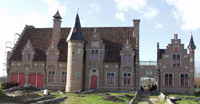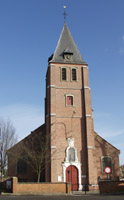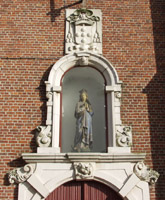The Meetjesland in the north of East-Flanders, Belgium

The Overslag
This town lies literally on both sides of the Belgian-Dutch border. In the middle of the Overslag Polder we're 1.7 meters above sea level (actually above "Nauwkeurig Amsterdams Peil" (N.A.P.) (Precise Amsterdam Level). The center of the Overslag town is undoubtedly more than 2 meters above N.A.P. "Bovenhoek" is partly above 5 meters. ("Boven" means upper, higher, above and "hoek" is corner.)
 On the spot where the Overslag is situated lies a layer called the Formation of
Twente layer that reaches a height of at least 2 meters. The Formation of
Twente is a geological layer dating from the last Ice Age when in our region there
was a tundra climate. It consists of layers of sand with here and there
smaller layers of peat. If there was peat in the lower lying regions it has
without a doubt been dug out a long time ago because the high ground of the
Overslag was an ideal place to start a commercial activity such as peat digging.
On the spot where the Overslag is situated lies a layer called the Formation of
Twente layer that reaches a height of at least 2 meters. The Formation of
Twente is a geological layer dating from the last Ice Age when in our region there
was a tundra climate. It consists of layers of sand with here and there
smaller layers of peat. If there was peat in the lower lying regions it has
without a doubt been dug out a long time ago because the high ground of the
Overslag was an ideal place to start a commercial activity such as peat digging.
Prehistoric objects such as stone arrow points and an axe were found in neighbouring Axel and Koewacht and just south of Zuiddorpe there are traces of an Iron Age farm. In the Waasland just east of our Meetjesland Roman artifacts were found and in Zelzate just west of the Overslag Carolingian coins were uncovered. All this leads us to believe humans were no doubt already active in what is now the Overslag in prehistory. And the region was perhaps continuously inhabited by humans from then on.
 The first written sources about the Overslag date from the Middle Ages.
They were of course related to the peat industry and the Axel Canal which ran from
Terneuzen via Axel to the Overslag. This canal was 21.7 km long.
The Overslag was no more than a few small houses. It was part of the parish
of Zuiddorpe.
The first written sources about the Overslag date from the Middle Ages.
They were of course related to the peat industry and the Axel Canal which ran from
Terneuzen via Axel to the Overslag. This canal was 21.7 km long.
The Overslag was no more than a few small houses. It was part of the parish
of Zuiddorpe.
The boats that were used around the year 1500 had a carrying capacity of about 5 tons. When they arrived in the Overslag at the end of the canal their cargo had to be carried over—that's the meaning of the word Overslag—to other smaller boats. There is a tarif list of 1504 which gives an idea of the nature of the goods that passed through the Overslag: all kinds of grain and fish especially herring, butter, wine, beer, salt, onions, leaks, mead, wool, planks, bricks, slates, lead, chalck, sheeps skins and peat. The right to levy a toll at the Overslag belonged to the duke who rented it out.
It was interesting to rent this toll right as long as the Axel Canal remained one of the most important waterways leading to Ghent but after the construction of the Sasse Canal in 1547 things surely went downhill fairly quickly because ships of a much greater tonnage passed through this new canal. In 1550 the annual rent of the "Tarief van Overslach" (the Overslach Toll) brought in a mere 12 pounds.
Of course like every other canal the Axel Canal had to be kept in shipshape and such a facelift was to take place in the middle of the 16th Century. In order to bring all interested parties to the point where they would cough up the funds the city counsel of Axel decided on a thorough inspection of the canal over its entire length. And that's how we know that in the Overslag there were only "drie huusekins", three small houses. One of these belonged to Augustijn Stijnaert who undoubtedly earned his crust of bread on or near the canal. The southern part of the Axel Canal was cleaned up despite the numerous protests mostly from further off regions who also had to pay their part.
 Only in the 1580s was the trajectory dug that separated the Overslag from the
other canals further south. A small "rabot" (floodgate) was
built. The discussion about prolonging the canal had been put off for
years. It was hoped this would win back some of the customers of the Sasse
Canal. But it was clearly too little too late. In 1586 the seadyke
west of Axel was pierced and much of the southern part of the canal disappeared.
Only in the 1580s was the trajectory dug that separated the Overslag from the
other canals further south. A small "rabot" (floodgate) was
built. The discussion about prolonging the canal had been put off for
years. It was hoped this would win back some of the customers of the Sasse
Canal. But it was clearly too little too late. In 1586 the seadyke
west of Axel was pierced and much of the southern part of the canal disappeared.
Since 1648 the borders of the "Koningsbodem" (King's Territory) and the "Statenbodem" (State's Territory) were more or less fixed thanks to the Treaty of Munster. The King's Territory is what is now Belgium and the State's Territory was the entire Low Countries. Until the early 17th Century life and the law were very similar north and south of this border. Only the religions were different: the Northern part of the Low Countries was reformed (Calvinist) and Roman Catholicism became the state religion of the south. Roman Catholic religious services were forbidden in the north.
In 1647 the last priests still present in the State's Territory were ordered to hand in the keys of their churches to a bailiff for religious affairs appointed by the States. Most of the objects in the church of Zuiddorpe had been brought to safety on the King's Territory (under Spanish control). (Zuiddorpe is north of the Overslag just across the border.) These objects such as statues and bells were used in other churches with the hope they would be returned to the confiscated church. They tried to sell off real estate donated to the church by the faithful with the proceeds going to the Catholic Church. Where one was too late for a sale the land fell into the hands of the reformed if it was situated on State's Territory.
Reformed religious services were forbidden in the south but by 1648 there were very few Protestants left in the south. Similarly Roman Catholic religious services were forbidden in the Northern Netherlands. Secret churches were installed, quite often in farm barns. Another solution for the faithful was to go to churches south of the border: the parish churches of Assenede, Wachtebeke, Moerbeke, Stekene, Saint-Gillis and Kieldrecht had among those attending their services a lot of people from north of the border even though some had to travel great distances and this mostly on foot.
During the violent French incursions of 1672-73 a few polders were once again set under water but after that the dikes were once again rebuilt. The Overslag Polder dates from 1672. The polder contained about 185 acres (75 hectares) and until 1773 discharged its water into the "Soute of Gentse Vaart" (Salty Canal or Ghent Canal). In 1698 the neighbouring Varempé Polder was dammed in. Most of it was the old Zuiddorpe Polder which had been drowned in 1682. (Zuiddorpe comes from "zuid" south and "dorp" town or village.) The Varempé Polder contained more than 659 acres (267 ha.). A year later the Moerbeke Polder with its 326 acres (132 ha.) was also reclaimed. For a long time the latter two polders also discharged their water in the old "Soute of Gentse Vaart".
In the course of the 17th Century the Canisvliet Polder was also dammed in and around Axel more polders followed. And at the end of the 18th Century the Axel Canal was closed off. It flowed via the "Groot Eiland" (Big Island) to Hulst. And that diminished the danger of inundations for the polders around Overslag.
In the second quarter of the 19th Century the surface area of the town of "Overslach" in the Netherlands was 549 "bunder". A toll collector lived here with his family, 4 persons in all. They were Protestant. The other inhabitants were Roman Catholic and they went to church in the parish church on Belgian territory. In 1840 on the Dutch side there were about 49 houses inhabitated by 51 families. Just after 1839 a border office was built. A school house was added in 1842. On average 45 pupils attended school here but during the Winter months their numbers grew to between 130 and 140. A third of the pupils came from Belgium. Finally the day of greatest fun was the 8th of September or the first Sunday after that (always on a Sunday) because then the town fair is always held.
In 1844 it was decided no longer to allow sheep to graze in the cemetery. Until that year mowing the grass in the cemetery or grazing animals there had brought in small amounts of money for the church.
In the south-eastern corner of the cemetery there is a Lourdes grotto. It dates from 1925 and was built thanks to the enthusiastic support for this project by the Reverend Richard De Buyst, the then parish priest of the Overslag. The farmers of the parish brought on the building materials free of charge.
The Reverend De Buyst clearly liked his parish because he also gave 27.000 franks of his own money for a wall around the cemetery with in it 7 chapels for a display of the 7 sorrows of the Holy Virgin. The inauguration ceremony by Van Den Abbeele, Dean of Lochristi took place on 21 August 1927.
During WW II the bells of so many churches in our country were taken by the Germans. In the Overslag in 1942 they cut a hole through one of the tower walls and unceremoniously threw the big bell down through this hole. In 1949 when Philibert Seys was the village priest the war damage was repaired by a firm called De Bruyne Victor from Wachtebeke for the sum of 18.250,00 franks. And a new big bell was hung in the tower on 17 November 1953. It weighed 587 kilograms. It was cast by Michiels, a firm from Doornik (Tournai). Its godfather was Henri Noë and its godmother was Mrs. Achiel Spanhove. The bell was consecrated by the Reverend Dean Verhegge from Lochristi.
In 1977 the Overslag church was once again in need of important repairs. On 2 October 1977 the church wardens of the parish were all present: René David, the president, Omer De Cock, the secretary, Raymond Noë (Henri's son), the treasurer, the Reverend Jan Verlijsdonck, the parish priest and finally the members Achiel Van Acker and André De Smet. The spire, the roof, the gutters all had to be seen to. And inside all the walls had to be cleaned and repainted. In other words: a major renovation. The job of repainting would drag on for 8 long years. The repairs of the stained glass windows would last from 1981 to 1989 and in 1995 scaffolding once again surrounded the church tower.
The Overslag church still has its purgatory.
In the 18th Century many cemeteries in Flanders had their purgatory. What's the origin of these purgatories ?
In the Middle Ages when the poor were buried in very shallow graves, old human bones and skulls were found laying about on many cemeteries. Until they were gathered together and piled up somewhere perhaps more to make the place look a bit more orderly than for any other reason. That's how the ossuary ("beenderhuys") originated.
In the Catholic Church there are the saints who after their death go directly to Heaven. There were those who didn't repent and died with one or more deadly sins on their conscience, they went to hell and then there were those who didn't immediately merit eternal heavenly bliss because they still had to atone a while for their sins. They spent some time in purgatory. The living prayed for these souls and the ossuaries looked like the ideal place to say those prayers. Perhaps here they might also comtemplate on their own fate if they didn't better their life. Later on when it seemed once again better to bury the bones of the dead the ossuaries were transformed into purgatories and bones and skulls were replaced with statues or paintings of souls being tempered by fire.
In the Overslag the purgatory is behind the church and the painting of the burning souls is on a wooden panel that has suffered much from the elements. The accounts call it a calvary instead of a purgatory. It was repainted in 1866 by Jan Gijsel, a painter from Zuiddorpe. And again in 1885, this time by Carel Gijsel who probably was the son of Jan Gijsel.
Source: "Geschiedenis van de Parochie Wachtebeke-Overslag en het Kerkgebouw" (History of the Wachtebeke-Overslag Parish and the Church building) by the Heemkundige Kring "Oud-Wachtebeke", the Old-Wachtebeke Regional Circle, 1996.

More pictures
Our Meetjesland
— Table of Contents
— Find something in this Meetjesland website

MijnPlatteLand.com
Most recent update : 22-04-2021
Copyright Notice (c) 2025